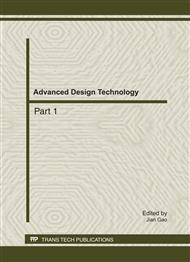[1]
Zhenguo Wang, Xiaoqian Chen, Weihua Zhang: Research on the Theory and Application of Multidisciplinary Design Optimization of Flight Vehicles. National Defense Industry Press, BeiJing. 2006.
Google Scholar
[2]
Cramer: Problem Formulation for Multidisciplinary Optimization. SIAM Journal of Optimization, No.4, November 1994, pp.754-776.
Google Scholar
[3]
Dennis, J.E., and Lewis, R.M.: Problem Formulations and Other Optimization Issues in Multidisciplinary Optimization. AIAA Symposium on Fluid Dynamics, Colorado Springs, CO, June 1994, AIAA pp.94-2196
Google Scholar
[4]
Braun R., Gage P., Kroo I., and Sobieszczanski-Sobieski J.: Implementation and Performance Issues in Collaborative Optimization. Proceedings 5th AIAA/USAF MDO symposium, Bellevue, WA, Sept. 1996, AIAA pp.96-4017
DOI: 10.2514/6.1996-4017
Google Scholar
[5]
R. S. Sellar, S. M. Batill, J. E. Renaud: Response Surface Based, Concurrent Subspace Optimization for Multidisciplinary System Design. AIAA 96-0714
DOI: 10.2514/6.1996-714
Google Scholar
[6]
Sobieszczanski-Sobieski, J., Altus, T. D., Phillips, M., and Sandusky, R.: Bi-Level Integrated System Synthesis (BLISS) for Concurrent and Distributed Processing. Sept. 2002, AIAA Paper 2002-5409.
DOI: 10.2514/6.2002-5409
Google Scholar
[7]
Brown, N. F. and Olds, J. R.: Evaluation of Multidisciplinary Optimization (MDO) Techniques Applied to a Reusable Launch Vehicle. 2005. AIAA 2005-707.
DOI: 10.2514/6.2005-707
Google Scholar
[8]
Perez, R. E., Liu, H. H. T., and Behdinan, K.: Evaluation of Multidisciplinary Optimization Approaches for Aircraft Conceptual Design. Aug. 2004, AIAA Paper 2004-4537.
DOI: 10.2514/6.2004-4537
Google Scholar
[9]
Nathan P. Tedford and Joaquim R. R. A. Martins: On the Common Structure of MDO Problems: A Comparion of Architectures. AIAA 2006-7080
Google Scholar
[10]
Teng Long, Li Liu, Huai Jian Li: Study of Improved Multiple Discipline Feasible Strategy for Complicated System Optimization. Applied Mechanics and Materials Vol. 44-47 (2010), p.3264
DOI: 10.4028/www.scientific.net/amm.44-47.3264
Google Scholar
[11]
Fred van Keulen, Boyang Liu, and Raphael T. Haftka: Noise and Discontinuity Issues in Response Surfaces Based on Functions and Derivatives. 41st AIAA/ASME/ASCE/AHS/ASC Structures, Structural Dynamics, and Materials Conference and Exhibit, April 3-6, 2000, Atlanta, Georgia. AIAA-00-1363
DOI: 10.2514/6.2000-1363
Google Scholar
[12]
Martins, J. R. R. A., Sturdza, P., and Alonso, J. J: The Complex-Step Derivative Approximation. ACM Transactions on Mathematical Software, Vol. 29, No. 3, Sept. 2003, p.245–262.
DOI: 10.1145/838250.838251
Google Scholar
[13]
Venter, G., Haftka, R., and J. H. Starnes: Construction of Response Surface Approximations for Design Optimization. AIAA Journal, Vol.36, No.12, December 1998, pp.2242-2249.
DOI: 10.2514/2.333
Google Scholar
[14]
T. D. Robinson, M. S. Eldred, K. E. Willcox, R. Haimes: Strategies for Multifidelity Optimization with Variable Dimensional Hierarchical Models. AIAA 2006-1819
DOI: 10.2514/6.2006-7114
Google Scholar
[15]
Jasmin Turcotte, Jean-Yves Trepanier and Christophe Tribes: Integration and Multidisciplinary Design Optimization of a Simplified Gas Turbine Model Using Perl and iSIGHT. AIAA 2004-4425.
DOI: 10.2514/6.2004-4425
Google Scholar
[16]
Huang Qingnan, Shen Xiuli,Tian Jing: Turbine Blade Serrated Crown of Pre-twist Design. Aeroengine. Vol.34 (2008), pp.5-9.
Google Scholar
[17]
Peggy L. Tally, Yesh P. Singh: Design Modification of a Gas Turbine Blade Shroud. Proceedings of the 2005 ASEE Gulf-Southwest Annual Conference
Google Scholar
[18]
Nava, Irene and Nagy, Douglas: Selection of Overlays for Single Crystal Shrouded Turbine Blades. ASME Turbo Expo 2002. Amsterdam, Netherlands. GT-2002-30661.
DOI: 10.1115/gt2002-30661
Google Scholar
[19]
Editorial Committee of Chinese Aeronautical Material Handbook: Chinese Aeronautical Material Handbook. Beijing: Chinese Standard Press, 2002. p.815.
Google Scholar


